Going to the gym is fun, but what if you could bring that fun right into your own home? That's exactly what we're here to talk about today!
We understand that you already know the importance of keeping your little ones active and engaged, especially when staying home is more common. But fear not! You don't need fancy equipment or a huge space to create a Kindergym experience at home.
As gym coaches, we understand parents' pressures in balancing work, household chores, and childcare. That's why we're thrilled to offer practical tips and ideas for bringing the joy of Kindergym right to your doorstep.
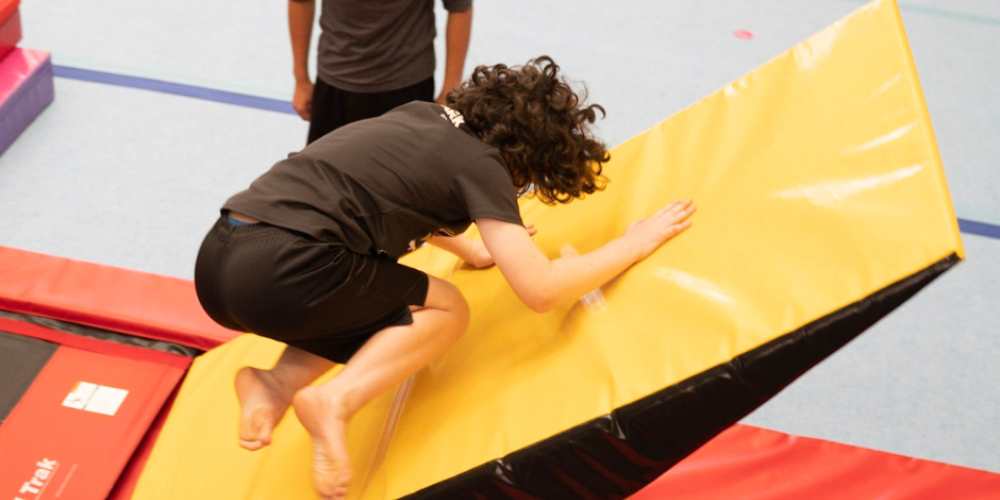
As I've said earlier, we want to encourage parents not just to leave the fun and excitement of Kindergym activities at the gym. Don't get me wrong. It's always been a pleasure for us gym coaches to see your kids thriving and having a blast in our facilities.
But why stop the fun there?
By bringing Kindergym activities into your home, you're not only providing your children an opportunity to stay active and engaged but also creating valuable moments for bonding and learning.
We all understand how crucial it is to warm up those small bodies before engaging in pleasant activities. Try a game of "Simon Says" in which you offer directions like "touch your toes" or "hop like a bunny," and your children follow along. It's a terrific way to get those muscles moving and the laughter flowing!
Turn your living room into an enormous obstacle course! Create a fun task for your children using pillows, cushions, and whatever else you can find. Make them crawl under tables, jump over pillows, and balance on a tape line on the floor. It's like having a miniature adventure park right in your own home!
It's time to put your balancing abilities to the test! Make a makeshift balance beam out of a firm surface, such as a piece of wood or a strip of tape on the floor. Challenge your children to walk heel-to-toe, bounce on one foot, or balance while collecting toys along the route. It's an excellent approach to developing strength and coordination.
Grab some scarves, ribbons, or streamers and unleash your imagination! Encourage your children to whirl, swirl, and dance around the room, discovering new rhythms and patterns. You can make it a storytelling adventure by having them act out scenes from their favourite stories or create their own.
Create sensory bins with exciting objects like rice, beans, or water. Allow your little explorers to dig in and find hidden treasures such as little toys or objects. It's an excellent method to engage their senses and pique their interest.
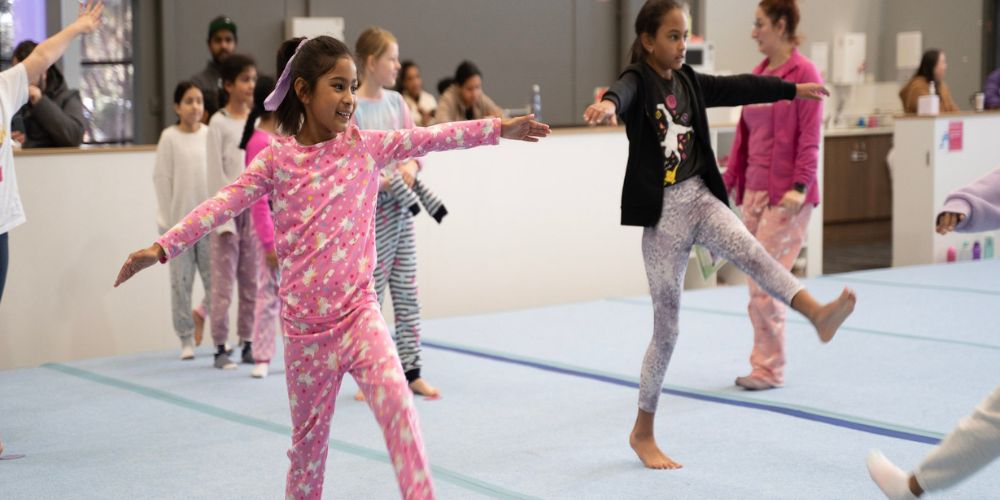
Kindergym at home is truly fun, but like any activity, it comes with its own set of pros and cons. Let's take a closer look:
Understand that Kindergym sessions at home may not always go as planned, and that's fine! Be adaptable and responsive to your child's mood, energy level, and hobbies. It's normal for your child to be uninterested in scheduled activities sometimes. Accept spontaneity and be willing to modify your plans on the fly. Being adaptable enables meaningful interactions with your child, regardless of the activity.
Involve your kid in creating and implementing Kindergym activities to foster a sense of ownership and team effort. Allow your child to help choose which activities to conduct during Kindergym sessions or aid in setting up the room. This not only gives them more decision-making authority, but it also increases your team cohesion. Working together teaches important skills such as collaboration, problem-solving, and responsibility.
Concentrate on easy, accessible activities that require little setup and equipment. You don't need expensive equipment or intricate setups to have a successful Kindergym session at home. Jumping, balancing, and crawling are all simple exercises that can help promote physical development and make the activity enjoyable. Plus, keeping things simple decreases stress for you and your child, making the entire process more enjoyable.
Recognise and praise your child's accomplishments, no matter how modest, throughout Kindergym sessions. Recognise and appreciate your child's efforts, mastering a new skill, finishing an obstacle course, or simply keeping attentive during the session. Celebrating little victories gives them more confidence and enthusiasm to continue participating in Kindergym activities.
Approach Kindergym classes with a good attitude and plenty of tolerance, especially if things don't go as expected. Remember that Kindergym is about having fun and encouraging your child's development, not perfection. Maintain a pleasant and patient attitude, even if your youngster struggles with particular activities or loses interest rapidly. Encourage, support, gently guide, and remember that development takes time.
Make safety a key priority during kindergarten classes by providing a safe environment and continuously monitoring your child. Before beginning any activity, ensure the area is safe and that any equipment utilised is robust and appropriate for the age group. Always supervise your kid, especially during climbing, leaping, or balancing activities. You can confidently enjoy Kindergym sessions by prioritising safety, knowing your kid is safe from accidents or injuries.
Yes, Kindergym activities allow children to interact with their peers, practise sharing and taking turns, and improve communication skills through cooperative play and group activities.
There are numerous online communities, forums, and social media groups where parents may share ideas, tips, and experiences about Kindergym at home. You can also get instructional videos and information from credible websites online.
One approach is to make Kindergym activities enjoyable and interesting by adding games, music, and imaginative play. You can also let your child choose the activities and give them praise and encouragement for their accomplishments.
Numerous inclusive Kindergym activities can be customised for children with special needs. Considering each child's unique needs and abilities is critical while planning activities. Consulting with a paediatric therapist or specialist may also be beneficial in developing a personalised Kindergym programme.
A kindergym at home is a fun way to keep your kids active and engaged. It provides numerous benefits for their physical, cognitive, and social development. By embracing flexibility, involving your child in the process, and prioritising safety, you can create memorable experiences that promote bonding and learning. So, clear some space, gather your supplies and prepare to embark on a journey of fun and growth with your little ones. With a positive attitude and a willingness to adapt, Kindergym at home can be a rewarding adventure for the whole family. Get ready to unleash your inner gymnast and make lasting memories together!
We believe in the power of play, laughing, and making lasting memories. If you're a busy parent looking for the perfect recipe to integrate pleasure, physical exercise, and organized playtime into your child's routine, you've come to the right spot!
In this blog article, we'll dive deep into the fascinating world of gymnastics with kindergym and learn how to create a weekly calendar that easily includes these wonderful excursions. We recognize that as a parent, you seek to offer a loving atmosphere for your children that supports their growth, feeds their imagination, and fosters their social relationships.
But first, envision your child's eyes light up with delight, their laughs filling the air, and their confidence skyrocketing as they overcome each new hurdle. That is the beauty of kindergym, and we are here to assist you incorporate it into your weekly routine.
So grab a cup of coffee (or your favourite beverage) and join us as we reveal the keys to creating a weekly routine that offers delight to your child and simplifies your hectic life. Let's plan a calendar full of adventure, laughter, and fun!
Are you prepared? Let's get started!
Okay, fellow motherhood superheroes, let's plunge into the fascinating scheduling world! "Why is a proper schedule such a big deal?" you may be asking. Well, buckle up because we're about to reveal the amazing capabilities a well-crafted schedule offers you and your child.
Life can seem rather hectic, especially when balancing work, errands, and the never-ending obligations of parenthood. But don't worry; a solid timetable is your dependable partner, swooping in to bring order to the chaos. You may tame the chaos and create a quiet and predictable atmosphere for your children by following a well-structured schedule.
Time is our arch-nemesis, sliding past our fingers like a slippery eel. With a superhero-worthy schedule, though, you become the master of time! You educate your child on how to be a superhero by ensuring they have enough time for school, play, and amazing kindergym adventures. It's a talent they'll have for the rest of their life.
Including kindergym exercises into your calendar opens a world of developmental superpowers for your kid. Kindergym encourages physical development, coordination, and extremely strong gross motor abilities. You're providing your little hero frequent opportunities to flex their muscles, develop their talents, and have fun by scheduling kindergym time.
Superheroes understand the value of self-care, and a routine promotes your child's health and happiness. You make time for nutritious meals, pleasant dreams, and the rest they require to replenish their abilities. Furthermore, by incorporating good behaviours into their routine, you prepare them for a lifetime of happiness.
A well-planned timetable becomes your child's ultimate attention aid in a world full of distractions. You may build a focus fortress by allocating certain time windows for various activities, including kindergym. It's like wearing noise-cancelling headphones for your child, allowing them to delve deep into each work, learn faster, and reach their full potential.
Every superhero understands that the true superpower is the strength of familial relationships. You're organizing time when you use a timetable and generating times of true connection and affection. Family bonding time becomes precious for laughing, adventures, and creating lifelong memories.

Begin by taking note of your child's interests and talents. Do they enjoy climbing, leaping, or balancing? Understanding what fascinates children will allow you to tailor kindergym activities to their interests.
Consistency is essential! Choose and stick to particular days and hours that work best for your family. A routine gives consistency and allows your kid to expect and look forward to their kindergym adventures.
Consider your child's other obligations and duties, such as school, playdates, and family time. Find a happy medium that allows for kindergym without overburdening their schedule. Remember that the main goal is to develop a well-rounded regimen.
Take into account your child's energy levels throughout the day. Do they prefer the mornings or the afternoons? Schedule your kindergym activities during peak energy to maximize their enjoyment and involvement.
Because life is full of surprises, plan for flexibility in your child's routine. Allow for unexpected events or spontaneous experiences. It's fine to alter and adapt as necessary as the spirit of adventure and enjoyment is maintained.
Meet other families that are interested in kindergym. Join local clubs, go on playdates, and share tips and ideas. The encouragement and companionship of other parents will improve your child's kindergym experience and foster long-lasting connections.
Make time in your calendar for devoted family time. Participate in kindergym exercises, cheer them on as they overcome obstacles, and celebrate their accomplishments. Family engagement offers an added dimension of fun and enhances your relationship with your child.
As a caring mother, you undoubtedly think about the best time of the week for your children to attend kindergym sessions. I realize picking a time that works for your child's needs and your family's schedule is vital. Let me walk you through some aspects to help you make this decision with confidence:
When it comes to smaller children, such as toddlers, they frequently experience a surge of energy in the mornings. Scheduling kindergym courses earlier in the day can be a terrific way to capitalize on their natural excitement and keep them interested. Conversely, older children may have greater energy in the afternoons or nights. You know your child best, so consider when they appear lively and ready for action.
Examine your child's daily schedule to see when they have fewer responsibilities or distractions. Suppose they already have other activities or lessons on particular days of the week. Pick a day when they are more available and energized.
Some families opt to enrol their children in kindergarten sessions during the week. Because fewer participants, your child will receive more personalized attention from the instructors. However, it may be an option if both parents can join or if weekends are more convenient for your work schedules.
Remember to take your child's specific preferences and temperament into account. Some children are bright and energetic in the mornings, while others need time to warm up and become more active in the afternoons. Pay attention to their natural cycles and find a time that works for them.
It's totally fine to experiment with different time slots at first. Examine your child's activity levels, excitement, and general happiness during the courses. Based on their input and observations, you may modify it to locate the sweet spot that works best for your kid.
You should bring a water bottle for your child to keep hydrated throughout the lesson. Some programmes may ask for extra supplies such as a light snack, a change of clothing, or a towel. If there are any unique needs or recommendations, it is essential to verify with the individual programme.
It is natural for youngsters to be timid or reluctant at first. Kindergym lessons are intended to be welcoming and helpful. Experienced teachers understand how to create a friendly atmosphere and encourage children to engage at their speed. Most children gradually grow more at ease and actively participate in the activities.
The frequency with which your kid attends kindergym lessons might vary depending on their age, schedule, and personal preferences. Attending one or two weekly lessons benefits many families in terms of their child's growth and enjoyment. You may, however, pick a frequency that works best for your family's schedule and your child's degree of interest.
Parent engagement is encouraged in several kindergym programmes, particularly for smaller age groups. Participating alongside your child may improve their experience, create opportunities for bonding, and allow you to assist and support them during the activities. However, restrictions differ, so check with the individual programme for their parent involvement guidelines.
Creating a weekly calendar for your kid incorporating kindergym activities may be a joyful and helpful experience. You may create an engaging kindergym journey that fits effortlessly into your family's life by following the stages in this book and considering your child's hobbies, energy levels, and general schedule.
A good schedule is vital because it gives your child structure, regularity, and expectation. It enables children to participate in activities encouraging physical growth, coordination, social engagement, and general well-being. You can guarantee that your kid has enough time for kindergym while also considering their other responsibilities and the need for flexibility with a well-balanced plan.
So, embrace the excitement of kindergym and plan a routine that fires your child's delight, encourages their growth, and enhances your family tie. Prepare for a wonderful journey of laughter, learning, and unending fun. Happy scheduling, and have fun exploring the beautiful world of kindergym!
Kindergym is a physical training program developed for young children between the ages of one and five. It is a safe and exciting approach for children to engage in age-appropriate activities that improve physical, cognitive, and social development.
A child's early years are an important time in their development since this is when they learn the fundamental abilities that will serve as the basis for all of their future learning and growth. By giving kids a chance to learn and develop in a fun and engaging setting, kindergym is a great activity that can promote this period of development.
Read further as we will be discuss to you why kindergym is beneficial for your child's early development!
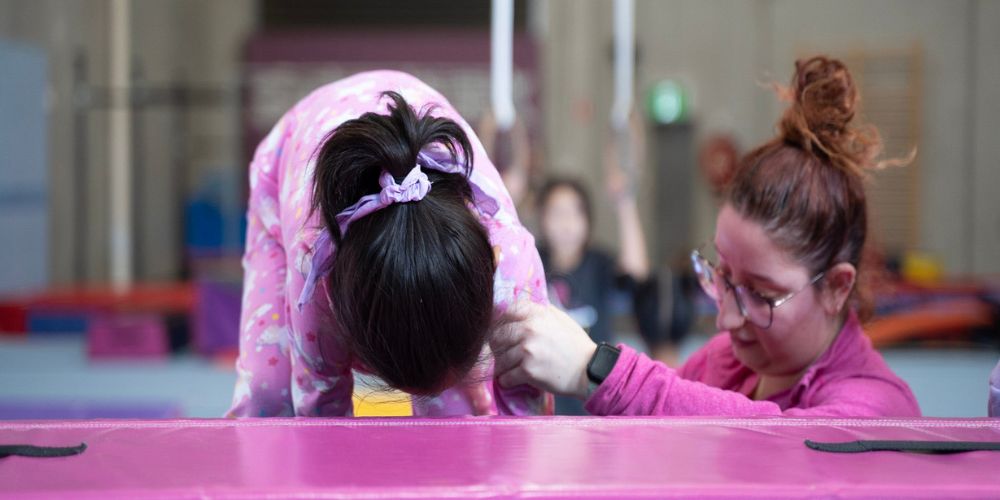
In an article released by Edith Cowan University, early childhood development is defined as the study of a child's physical, emotional, and social growth and development throughout the first few years of life. It also describes how their capacity for thought and communication changes throughout time. These areas of development are all crucial in a child's early years and are closely related to one another.
Kindergym offers various benefits for early childhood development, including:
Children's gross motor and fine motor abilities are developed through kindergym exercises. Cling, rolling, leaping, and balancing encourage toddlers to use their whole body, enhancing their coordination, balance, and general physical aptitude. Youngsters also grasp their body's motions and spatial awareness through these exercises.
Kindergym promotes cognitive skills by fostering brain growth. The exercises involved in kindergym assist youngsters develop spatial awareness, problem-solving skills, and decision-making ability. Children can think creatively and strategically as they overcome challenges, which can help them later in life when pursuing educational goals.
Kindergym allows children to engage with their classmates and adults in a friendly and safe setting. Children learn to communicate effectively, collaborate, and create friends by working in teams and sharing equipment. These social abilities are vital for their emotional and psychological well-being.
Kindergym helps children build independence by encouraging them to take chances and attempt new things. With the help of their parents or teachers, youngsters may explore their strengths and acquire confidence in their abilities. Kindergym creates a sense of self-awareness and self-esteem in children as they learn to do tasks independently and enjoy their successes.
Kindergym encourages a healthy lifestyle by encouraging children to be physically active from an early age. When youngsters learn to like exercise, they are likelier to continue being physically active. This can avoid obesity, diabetes, and other health difficulties in adulthood. Kindergym also teaches youngsters about the need for an excellent diet and healthy practices.
Kindergym lessons are typically organized to be entertaining, safe, and developmentally suitable for young children. A typical class may include a warm-up, a variety of stations or exercises, and a cool-down session. Here's a summary of what children should expect during an average kindergym class:
The warm-up generally contains a range of exercises and motions that get children's bodies ready for physical activity. This may involve stretching, jumping jacks, and other basic motions to promote blood flow and flexibility.
Children often move through some stations or activities after the warm-up. These might consist of physical exercises like running, crawling, or leaping and gymnastics apparatus such as balancing beams, mats, and trampolines. Each station is made to help in children's growth of particular physical and mental abilities.
A cool-down hour after class typically includes stretching and relaxing techniques. This is crucial to perform to protect kids from harm and to settle them down after an energetic session.
Children's coordination, spatial awareness, and gross motor abilities are all improved through crawling and rolling exercises. Children can be encouraged to roll down slopes or soft mats, crawl through tunnels or over obstacles, or both.
Children that engage in balancing exercises improve their coordination, balance, and core strength. Examples include standing on one foot while walking along a balance beam or a low wall.
Activities like hopping and jumping help kids improve their balance, coordination, and leg strength. Their parents might encourage children to hop over tiny obstacles, hopscotch, or jump on trampolines.
Through climbing exercises, children can improve their upper body strength, balance, and coordination. Ropes, ladders, and climbing walls are a few examples.
Children can improve their social skills, gross motor abilities, and hand-eye coordination by playing with balls. Children might be encouraged by their parents to play basketball or soccer or toss and catch balls.
Through dancing, children can improve their coordination, rhythm, and gross motor abilities. Children might be encouraged by their parents to play dancing games, dance to music, or do easy routines.
Children participating in tumbling exercises improve their balance, coordination, and strength. Cartwheels forward rolls, and somersaults are a few examples.
Children are encouraged to use their imaginations, creativity, and social skills via imaginative play. Children might be encouraged by their parents to act out various scenarios, wear costumes, or play pretend.
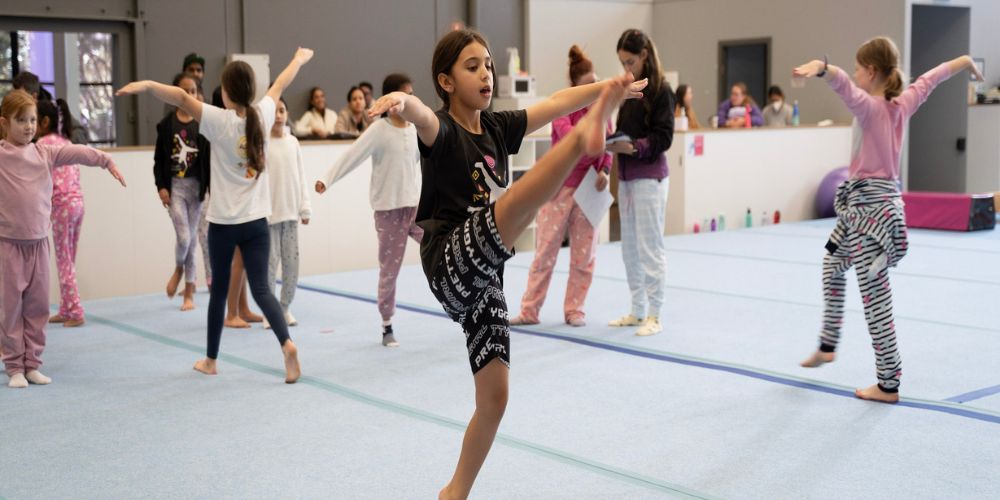
Here are some tips to get you started if you're interested in enrolling your child in kindergym:
Start by reading reviews of neighbourhood kindergarten programs written by other parents. In addition to having trained and experienced instructors, look for programmes with a good safety record. Consider the facility's philosophy and approach to ensure the programme meets your child's requirements and interests.
Talk to your kid about what to anticipate and the value of kindergym before the first lesson. They may become more at ease and enthusiastic about the encounter. You might also advise them to pack a water bottle, a small snack, and comfortable attire.
Ask your child about their experience and what they liked most after the first lesson. Encourage them to stay in kindergym if they had a good experience. They can also be reminded of the advantages of kindergarten and how it can aid in developing critical skills.
The key to kindergarten is consistency. Ensure your child is prepared and ready for each lesson, and encourage them to attend school regularly. This might assist them in enhancing their abilities and advancing over time.
Kindergym is appropriate for children from 6 months to 5 years old, depending on the lessons. Specific programmes could have distinct classes or age-specific age ranges.
Depending on the programme, yes. While some kindergarten programmes require parents to attend courses with their kids, others let kids go to sessions independently.
Most programmes advise going once or twice a week to show noticeable growth.
No, playing in the kindergarten gym is not usually a competitive activity. It is centred on learning new things and having fun in a welcoming and motivating atmosphere.
Early childhood development can benefit from kindergym in various ways, including the development of motor skills, cognitive abilities, social abilities, encouragement of independence, and promotion of a healthy lifestyle. Parents may allow their kids to learn these skills in a friendly and motivating setting by enrolling them in kindergym programmes.
Enrolling your child in a reputed kindergarten programme is something you should consider doing as a parent if you want to assist their development. Kindergym might be an excellent option for your kid since it has skilled and experienced instructors, an emphasis on safety and enjoyment, and various exercises to develop various abilities.
Explore the kindergarten programmes available to start supporting your child's development. Give your kid the gift of early childhood development, and watch them thrive!
Early childhood education and physical development for young children are the goals of kinder gym program. This program often includes various exercises and activities catered to the unique requirements of kids between the ages of 2 and 5. A crucial element of kinder gym programmes is the child-centred approach, which is crucial for the proper development of young children.
As a mother, I always want the best for my kids, especially their social and physical growth. The importance of a child-centred approach in a kinder gym programs is one of the reasons I am thrilled to speak with you about them.
According to an article published by the Department of Education, Victoria Government, a child-centred approach means:
At Skylark Sports, our Kinder gym program emphasises children's importance and needs. Although the teachers assist in learning and growth, the children are encouraged to participate actively in their education. This method respects and builds on the children's ideas, interests, and talents.
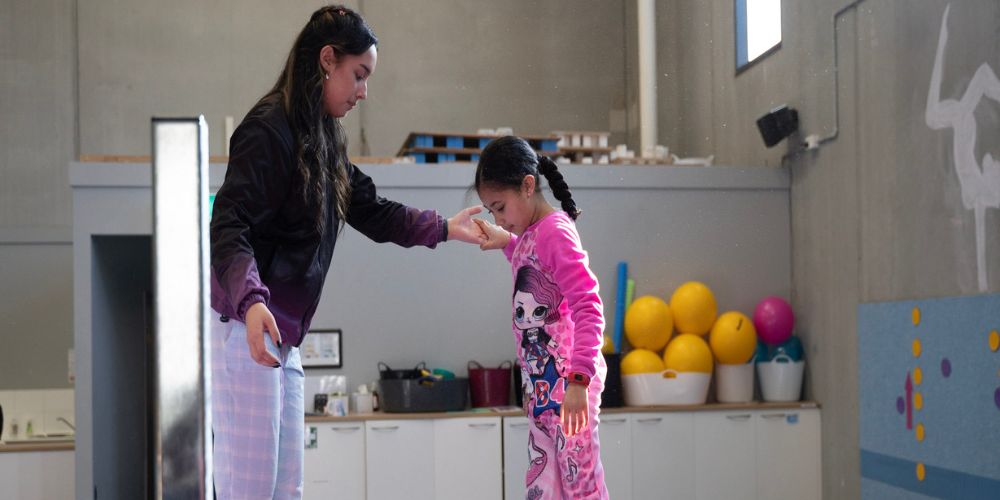
The child-centred method is a teaching concept that emphasises the student's needs and interests more than the instructor or the curriculum. This strategy is used in the Kinder Gym program by offering engaging activities that are age- and developmentally appropriate for young children. Examples of kid-friendly activities that can be included in a Kinder Gym program include as follows:
Give kids the freedom to play and explore the gym equipment without restrictions or limitations. This promotes imagination, self-expression, and creativity.
Construct obstacle courses that are difficult but doable for kids. Their coordination, balance, and gross motor abilities are all improved.
Play cooperative and team-building activities, including relay races or parachute challenges. This aids in teaching kids social skills like sharing and taking turns.
Include music and movement in the curriculum to provide kids with a platform for creative movement and dance.
I have personally seen the advantages of a kid-centred strategy in a kindergym program. Children are more interested and motivated to participate when they can actively participate in their learning and development.
Children's physical and social development depends on their active participation and engagement. Children are likelier to improve their literacy and motor abilities when participating actively. Additionally, they increase their self-esteem and sense of success.
Children have independence and self-confidence when they can explore and learn quickly. With the help of this method, kids may take charge of their education and are encouraged to participate actively.
Children are encouraged to utilise their imagination and creativity to explore new ideas and concepts through the child-centred approach. Children can use this method to express themselves in various ways, including play, music, and painting.
A child-centred approach encourages the growth of emotional and social intelligence. Children gain valuable interpersonal skills such as effective communication, conflict resolution, and connection building by working with others. Additionally, they can comprehend and control their emotions, which is crucial for their general well-being.
Each child's requirements are taken into account while using a child-centred approach. Children can study and develop at their rate in Kindergym classes, which helps them hone their strengths and conquer their limitations.
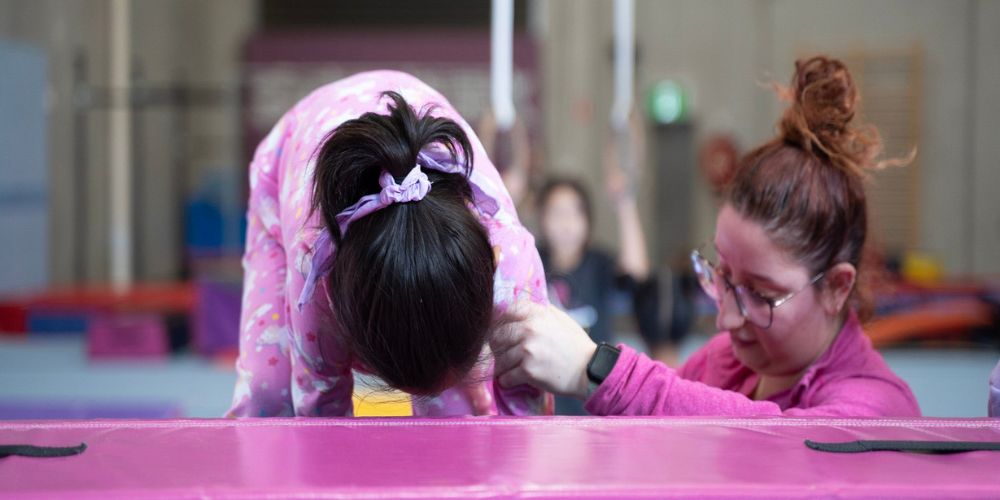
Kindergym instruction that is child-centred is crucial because it acknowledges that every kid is different and has particular needs, interests, and skills. This method aims to foster children's physical, social, emotional, and cognitive growth by establishing a secure and encouraging atmosphere where they can explore and learn quickly.
Kindergym trainers may adapt their activities and teaching strategies to match each child's unique needs and interests using a child-centred approach. Children's motivation, involvement, and sense of self-worth can all be improved by doing this. Additionally, child-centred strategies can support the development of strong bonds between students and their instructors as well as between students themselves.
Children and teenagers who engage in regular physical exercise can lower their chance of developing health disorders like heart disease, increase their cardiorespiratory fitness, grow strong bones and muscles, manage their weight, and lessen their anxiety and depression.
Running, leaping, balancing, tossing, catching, and other enjoyable activities like jumping and hula hooping are all acceptable. To help them develop their skills, resilience, and innate drive, you might encourage kids to compete against their times.
Incorporate particular opportunities for physical exercise into the daily schedule of the early years setting, like tummy time, crawling activities, or active games. Assess the indoor and outdoor spaces, and if necessary, reorganise them to provide a more open area for active play.
Children will learn to maneuver, balance, and lift objects while playing. Doing this gives them the basic movement abilities needed to maintain their physical activity throughout their lives. Physical play will support children's continued health and activity as they age. Additionally, it strengthens their muscles and bones.
A child-centred approach is critical for encouraging children's physical and social development in kinder gym programs. It promotes active involvement and engagement, self-directed learning and discovery, social and emotional intelligence development, physical literacy and gross motor abilities. We should prioritise finding programs that prioritise this approach as parents. By doing so, we can help our children develop into healthy, active, and socially competent persons.
As a mother, I understand how critical it is to provide our children with an opportunity to develop physical, social, and emotional abilities. Kinder Gym lessons are an excellent method of doing this. Kinder Gym is a fun and engaging programme for children aged 3 to 5, focusing on developing essential movement abilities such as running, leaping, and throwing.
Attending Kinder Gym lessons with your kid may provide several advantages, including improved coordination, balance, strength, socialization, and self-confidence. However, for your child to get the most out of these sessions, they must be well prepared.
Read further as we discuss in this blog the essential items your child should bring to their Kinder Gym sessions.
As every parent knows, children must have everything they need at the gym within reach. That said, you are responsible for ensuring your gymnast's suitcase is packed and ready to travel! You should include some items in her gym bag before she goes to practice.
The proper attire and footwear are required for your child's comfort and safety during Kinder Gym sessions. It is essential to pick attire that allows your child to move freely so they may completely engage in the activities. T-shirts, shorts, or leggings with a loose fit are perfect. Clothing that is overly tight or restricting might impair your child's range of motion.
Proper footwear is also necessary. Your youngster should wear shoes that are comfortable and have sufficient traction. Athletic shoes with non-slip bottoms are an intelligent alternative for preventing slips and fall. Sandals and flip-flops are not advised since they might be dangerous during physical activities.
Staying hydrated and refuelling after exercise is critical for your child's health and well-being throughout Kinder Gym sessions. Packing a water bottle and nutritious, portable foods for your youngster to enjoy during breaks is brilliant. This might assist them in remaining energized and focused during the session.
As moms, we understand how critical keeping our children healthy and safe is, especially during these trying times. As a result, packing personal hygiene products for your child's Kinder Gym sessions is critical.
Hand sanitiser or wipes can help reduce germ spread, keeping your kid and the rest of the class safe and healthy. Encourage your kids to routinely use sanitiser or wipes after touching shared equipment.
Bring a towel or extra clothing if your kid sweats or spills something during the lesson. This will keep them comfortable and avoid sweat-related skin irritation or illnesses.
In addition to the necessary materials, there are a few extras you should consider taking for your child's Kinder Gym lessons.
If the session is held outside, bring sunscreen and caps to protect your child's skin from the sun's damaging rays. Apply sunscreen before the session and bring extra to reapply during the day.
Small toys and activities also keep your toddler occupied during downtime. However, ensure the toys or games are safe, appropriate for the Kinder Gym atmosphere, and will not interfere with the session.
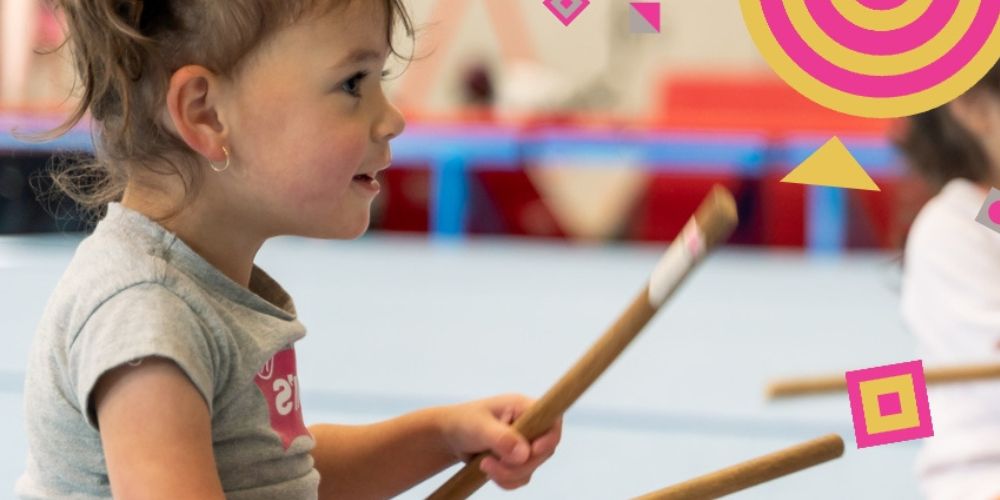
Participating in Kinder Gym lessons with your kid is an excellent method to encourage physical exercise and socialization. However, more than merely attending the lesson is required to make it worthwhile.
Here are some ideas for making every trip to your child's Kinder Gym session worthwhile:
Active participation with your kid is one of the finest ways to make Kinder Gym sessions worthwhile. Participate in the activities, cheer them on, and provide encouragement. Being present and involved at the moment will not only enhance your child's enjoyment of the event, but it will also build your bond with them.
While Kinder Gym sessions are a terrific method to encourage physical exercise, it is also crucial to encourage your kid to stay active outside of class. Take family walks, visit the park, or play backyard activities. You may help your child build healthy habits for life by including physical exercise in your daily routine.
Setting objectives for your kid might help them stay motivated and involved in their Kinder Gym sessions. Set attainable goals with them and track their development over time. Celebrate their achievements and assist them in setting new objectives as they continue to grow and develop.
Kinder Gym lessons are an excellent way for kids to socialize with friends. Encourage them to meet new people and participate in group activities. You can assist your kid in acquiring essential social and emotional abilities that will benefit them throughout life by encouraging socialization skills.
Finally, it would help if you support your child's involvement in Kinder Gym classes. Attend their performances and provide support and applause. You can assist your child in developing a feeling of confidence and self-esteem that will carry over into all parts of their life by demonstrating your support.
Most children will be okay with getting their daily exercise dosage if it's enjoyable. School-aged children are advised to engage in 1 hour or more of moderate to vigorous physical activity each day.
Children and teenagers aged 5 and 18 should strive to moderate to vigorous physical exercise at least 60 minutes daily, five days per week. During the week, engage in various physical activities to strengthen your bones, muscles, and movement abilities.
Numerous studies have shown that active kids are happy. Stress-reduction brain chemicals are released during physical activity. Any physical exercise is beneficial. Physically active kids are more adept at controlling their moods and have fewer fluctuations.
You may have heard that lifting weights might slow down growth. Weight lifting can damage the growth plates, which control bone development, and reduce height. There is no proof that high-impact sports like basketball, football, soccer, and gymnastics impair growth plates.
Our kids may benefit significantly from participating in Kinder Gym programs, including improved social and physical abilities. However, equipping them with the proper materials is crucial to ensure they get the most out of these sessions.
We can make sure our kids have a great time at Kinder Gym by packing goods like comfy clothing, appropriate footwear, water bottles, nutritious food, personal hygiene products, and optional items like sunscreen and small toys.
I also recommend letting your child help you pack their bag. This helps kids feel more prepared and enthusiastic for the session while teaching them responsibility and independence.
Through Kinder Gym, let's help our kids learn, develop, and grow. We can assist them in realizing their full potential and laying the groundwork for lifelong healthy habits by giving them all they require for a successful and enjoyable session.
We know you want nothing else but the best for your child as a parent. Part of that is choosing the appropriate activities that foster physical, social, and cognitive growth. This is where the kinder gym, a play-based educational activity created especially for young children.
Kinder gym is a play-based educational exercise that supports young children's physical growth, social skills, and cognitive abilities. Kids of all ages may benefit from kindergym in various ways, from developing their motor skills to sharpening their problem-solving skills.
In this article, we'll go over the advantages of a kinder gym in more detail, including how it affects kids' physical health, social skills, and cognitive growth. We'll also give you a few tips on maximizing your kinder gym sessions and provide insightful information on why the kinder gym is such a fantastic play-based learning activity for your child.
So let's get started and learn how kinder gym can support your child's development!
Kinder Gym is a physical fitness programme developed for young children designed to encourage mobility, discovery, and social engagement via play. Activities that encourage essential movement abilities, such as running, leaping, balancing, crawling, throwing, and catching, are generally included in Kinder Gym sessions. They also contain cognitive and social exercises that aid in developing critical abilities and habits in youngsters.
Kindergym is a play-based program that teaches children motor skills, coordination, balance, and flexibility through running, leaping, climbing, and tumbling. Kindergym programmes are usually taught by experienced teachers who provide a safe and enjoyable atmosphere for children to develop and explore their physical talents. Kindergym exercises are age-appropriate and help kids develop a love of physical activity and fitness at a young age.
Play-based learning is an educational strategy that emphasizes play's relevance in children's learning and development. It entails developing a learning environment that allows children to explore, experiment, and engage in imaginative play while simultaneously allowing them to gain critical skills and information.
According to Early Education Childhood and Care, play-based learning allows children to actively and imaginatively interact with people, things, and the environment. Children may organize, construct, manipulate, pretend, explore, investigate, create, engage, imagine, negotiate, and make sense of their worlds while playing. It encourages a child's holistic development (physical, social, emotional, cognitive, and creative). Depending on how it is used, it may also enhance a wide range of reading and numeracy abilities. The role of the instructor in scaffolding play is critical.
In an article written by wonderschool.com, play-based learning consists of the following elements:
The following components are included in play-based learning:
A youngster decides to play, how they will play, and how long they will play. An adult may commence play by inviting or suggesting it, but the kid controls the rest.
Play is pleasurable for children. This emotional factor is critical. There may be occasional difficulties or conflicts during play, but it is generally enjoyable.
During play, a youngster has plenty of time to explore and discover. They are guided by their interests rather than predefined norms or strategies.
There is no conclusion or learning objective. Instead, it is the game's process that is significant.
Imagination,' make-believe,' or 'playing pretend' are frequently used in play.
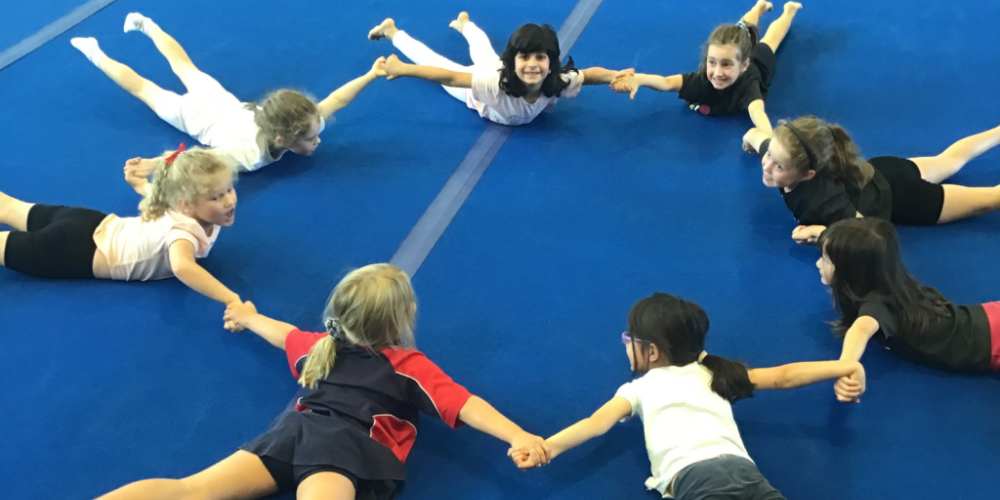
The Kindergym programme was created to teach children the joys of movement and fitness at a young age. Its goal is to help your child develop the knowledge and habits essential to living a healthier life.
At Skylark Sports, where we offer an inclusive kindergym performance program, you would expect to see your kids enjoy the following activities:
During Kinder Gym lessons, you may usually expect the following:
Kindergym exercises can provide several advantages to young children. Here are some of the main benefits:
Gross motor abilities, balance, coordination, and total physical health are all enhanced by kindergym exercises. Children can benefit from these exercises by strengthening their muscles and increasing their flexibility and endurance.
Regular participation in Kinder Gym may enhance your child's physical fitness, increasing cardiovascular endurance, strength, and flexibility.
Through encouragement and positive reinforcement, children can develop confidence and self-esteem during Kinder Gym lessons.
Sessions at Kinder Gym may help kids develop a love of exercise, which can lead to a healthy and active lifestyle.
Sessions at Kinder Gym allow kids to engage with other kids their age, fostering friendships, social skills, and a feeling of belonging.
Children may learn emotional abilities, including empathy, self-awareness, and emotional control, through kindergym exercises. Children can learn to control their emotions and express themselves positively through these activities.
What should I bring to KinderGym? All you needed was a water bottle. Please ensure your children have dressed appropriately, such as in leggings, shorts, or tracksuit pants. KinderGym does not allow dresses or tights.
Depending on the curriculum, the number of Kinder Gym classes may vary. Attendance once or twice a week is often advised.
Your kid can skip prior experience or equipment to participate in Kinder Gym programmes. The programme will provide age-appropriate equipment and training.
Kinder Gym programmes provide children with a fun and engaging setting to explore physical activity and movement, fostering a love of physical exercise from an early age.
Kinder Gym is an essential program for young children that encourages physical exercise, healthy development, and social connection. Children may acquire essential movement skills, increase physical fitness, improve coordination and balance, stimulate cognitive and social development, create confidence and self-esteem, foster a love of physical activity, and engage in social interaction through Kinder Gym.